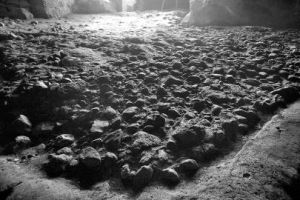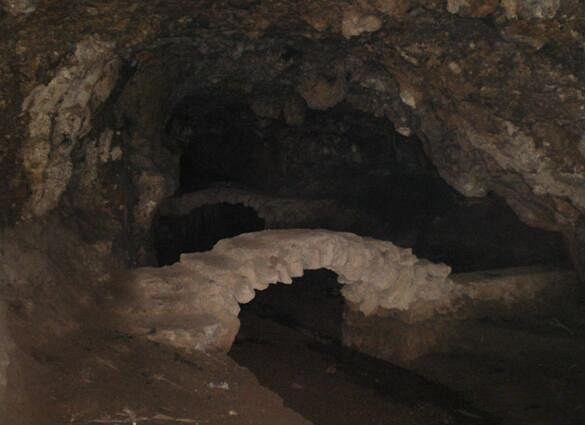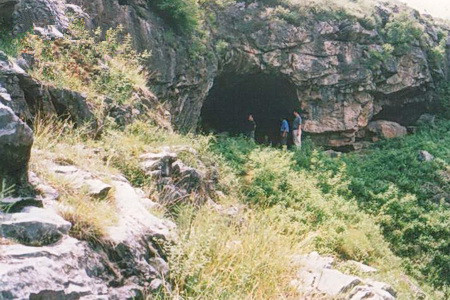Guoshandong Cave Paleolithic Site in Zhaotong City
Chinese Name: 昭通市过山洞旧时器遗址
English Name: Guoshandong Cave Paleolithic Site in Zhaotong City
Overview of the Guoshandong Cave Paleolithic Site
The Guoshandong Cave Paleolithic Site is located in the village of Guoshandong, approximately 15 kilometers north of Zhaotong City in Yunnan Province, China, near the town of Beizha. The cave consists of two main sections: the front cave, which faces slightly northeast and has a width of over 10 meters and a maximum height of about 5 meters, and the rear cave, which faces southeast and is somewhat smaller.
In November 1982, a municipal cultural relics survey team discovered mammalian fossils and a human tooth fossil about 20 meters inside the rear cave. Experts identified the mammalian fossils as belonging to species such as the Asian saber-toothed cat, Chinese rhinoceros, and monkeys, dating them to the Late Pleistocene or early Late Pleistocene epoch. The human tooth fossil, named the “Zhaotong Man,” marks the first discovery of an early Homo sapiens fossil in Yunnan Province.
Additional Archaeological Discoveries
Following the initial discovery of Paleolithic remains in the rear cave of Guoshandong, another site was found on the left side of the front cave, indicating the presence of a Neolithic-era settlement. This shows the continuity of human habitation in the region, bridging different prehistoric periods.
Related Archaeological Sites
Wild Boar Cave Neolithic Site:
Located 300 meters north of the Xunlongwan Village Office in Sayu Township, Zhaotong City, this cave measures 3 to 4 meters wide and 1.5 to 3 meters high, extending more than 10 meters in depth. It features side caves that are 4 to 5 meters deep. Artifacts excavated from the site include stone axes, adzes, net weights, and pottery (red sandy and gray clay pottery), as well as human jawbones and animal remains like wild cattle and dogs. The tools found at Wild Boar Cave are generally cruder than those from Guoshandong, suggesting the Wild Boar Cave site may predate Guoshandong Cave.
Significance of the Discovery
The initial exploration of Guoshandong Cave in April 1981, followed by subsequent excavations, highlighted Zhaotong’s significance as one of the three major cultural origins in Yunnan Province. The discovery of the “Zhaotong Man” fills a crucial gap in Yunnan’s prehistoric timeline, bridging the evolutionary stages from ape-man to late Homo sapiens. The Guoshandong Cave findings have shed light on the early human activities and environmental conditions in the region, emphasizing its importance in understanding the broader narrative of human evolution in China.
How to Get There
- Location: The Guoshandong Cave Paleolithic Site is situated approximately 15 kilometers north of Zhaotong City, near the town of Beizha.
- Transportation: Visitors can take a taxi or drive from Zhaotong City, following the directions to Beizha Town and then to Guoshandong Village. It is recommended to use a GPS or consult local maps for accurate navigation.
Travel Tips
- Plan Ahead: Research and verify the site’s opening hours, entrance fees, and any permits required for visiting the cave. Information can be obtained from local tourism offices or online resources.
- Choose the Right Time: To avoid crowds and enjoy a more peaceful visit, consider traveling during non-peak seasons or weekdays.
- Respect the Artifacts: Follow guidelines and avoid touching, marking, or damaging any artifacts. Maintain a quiet environment to ensure a respectful and enjoyable experience for all visitors.
- Dress Comfortably: Wear comfortable shoes suitable for walking and dress according to the weather conditions. Sun protection items like hats, sunscreen, and sunglasses are advisable.
- Bring Essentials: As there may be limited food and drink options near the site, bring enough water and snacks for your visit.
- Safety First: Pay attention to safety signs and be cautious when exploring the cave and its surroundings, especially in areas with steep or unstable terrain.
- Respect Local Customs: Be mindful of local traditions and customs. Show respect to the residents and their way of life.
- Plan Your Itinerary: Given the wide distribution of archaeological sites in Zhaotong, it is advisable to plan your visit in advance to ensure enough time to explore key locations.
- Environmental Responsibility: Help preserve the natural and cultural heritage of the site by not littering and avoiding any damage to the vegetation or surrounding areas.

 7 Days GolfingTour
7 Days GolfingTour
 8 Days Group Tour
8 Days Group Tour
 8 Days Yunnan Tour
8 Days Yunnan Tour
 7 Days Shangri La Hiking
7 Days Shangri La Hiking
 11 Days Yunnan Tour
11 Days Yunnan Tour
 6 Days Yuanyang Terraces
6 Days Yuanyang Terraces
 11 Days Yunnan Tour
11 Days Yunnan Tour
 8 Days South Yunnan
8 Days South Yunnan
 7 Days Tea Tour
7 Days Tea Tour
 8 Days Muslim Tour
8 Days Muslim Tour
 12 Days Self-Driving
12 Days Self-Driving
 4 Days Haba Climbing
4 Days Haba Climbing
 Tiger Leaping Gorge
Tiger Leaping Gorge
 Stone Forest
Stone Forest
 Yunnan-Tibet
Yunnan-Tibet
 Hani Rice Terraces
Hani Rice Terraces
 Kunming
Kunming
 Lijiang
Lijiang
 Shangri-la
Shangri-la
 Dali
Dali
 XishuangBanna
XishuangBanna
 Honghe
Honghe
 Kunming
Kunming
 Lijiang
Lijiang
 Shangri-la
Shangri-la
 Yuanyang Rice Terraces
Yuanyang Rice Terraces
 Nujiang
Nujiang
 XishuangBanna
XishuangBanna
 Spring City Golf
Spring City Golf
 Snow Mountain Golf
Snow Mountain Golf
 Stone Mountain Golf
Stone Mountain Golf
















